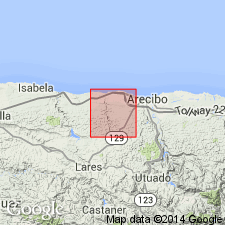
- Usage in publication:
-
- Camuy Formation*
- Modifications:
-
- Named
- Dominant lithology:
-
- Limestone
- Marl
- Chalk
- Sandstone
- AAPG geologic province:
-
- Caribbean region
Summary:
Named for town of Camuy, PR. Consists of limestone, marl, sandy chalk, and sandstone. In Camuy quad, divided into three members, but they are not readily traceable beyond quad borders. Estimated thickness about 200 m. Disconformably overlies Aymamon Limestone; underlies Pleistocene deposits. Age is Miocene.
Source: GNU records (USGS DDS-6; Reston GNULEX).

- Usage in publication:
-
- Camuy Formation*
- Modifications:
-
- Age modified
- AAPG geologic province:
-
- Caribbean region
Summary:
The Camuy Formation occurs on the north coast of Puerto Rico and consists of foraminiferal biomicrite with clay lenses, ferruginous calcarenite interbedded with chalky breccia, and in the upper part, chalky sandstone, sandstone, sandy limestone, and limestone. Maximum estimated thickness is 170 meters. The age of the Camuy is changed to late Miocene and early Pliocene.
Source: GNU records (USGS DDS-6; Reston GNULEX).
For more information, please contact Nancy Stamm, Geologic Names Committee Secretary.
Asterisk (*) indicates published by U.S. Geological Survey authors.
"No current usage" (†) implies that a name has been abandoned or has fallen into disuse. Former usage and, if known, replacement name given in parentheses ( ).
Slash (/) indicates name conflicts with nomenclatural guidelines (CSN, 1933; ACSN, 1961, 1970; NACSN, 1983, 2005, 2021). May be explained within brackets ([ ]).

